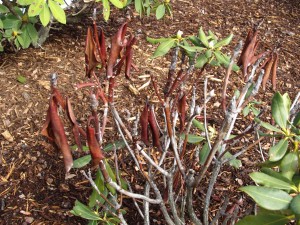Phytophthora disease (Phytophthora spp.) is the fatal cause of root rots, stem cankers and crown rots. Several hundred species of plants are susceptible, including redbuds, dogwoods, rhododendrons, camellias, white pines, firs, yews (Taxus spp.), and fruit trees. It thrives in warm moist saturated soils. Phytophthora may lie dormant in the soil for several years, waiting for a susceptible host plant and ideal environmental conditions.
Some common symptoms include yellow-green foliage, wilting, dead branches, and whole plant death. Infected leaves typically turn various shades of brown, die, and remain on the branches for several months.
Your best approach is to avoid the disease completely. Purchase only healthy trees and shrubs. Inspect the root ball for size dimension (compare to the top) and look for visible damage. Leave sick plants at the garden center.
Avoid plant stress by selecting the proper planting site. For example, most needle evergreens grow best in full sun, while broadleaf rhododendrons prefer partial sun. All demand a well-drained soil, preferably situated on a slight grade or slope. Do not plant in heavy clay or compacted poorly drained ground.
Prior to planting, remove all nylon and plastic burlap and twine around the root ball. Jute or cotton burlap and rope may be left around the rootball. Set most shrubs and trees at the same depth (as at the nursery). Fertilize plants in late winter at the proper amounts; overfeeding may worsen Phytophthora root rot infections. Water the plant(s) on site within three days after planting. Apply 2-3 inches of an organic mulch around the tree and do not pile mulch up around the trunk.
Once Phytophthora has been diagnosed, apply treatments of Subdue MAXX™ or Aliette™ fungicides in the spring and fall to prevent further disease spread. Fungicide treatments are quite expensive and removal of the sickly plant may be your best option.


 Posted in
Posted in 
